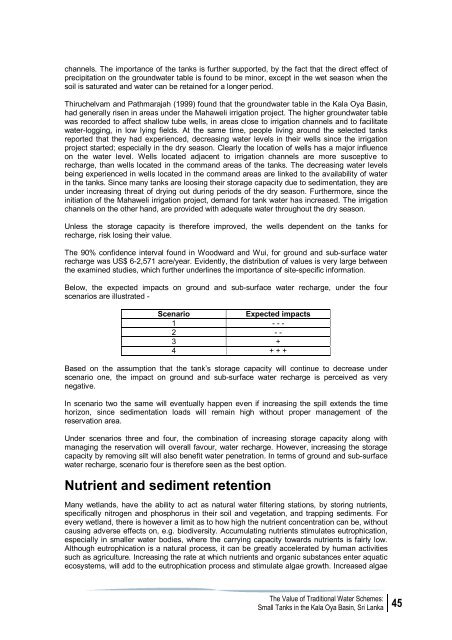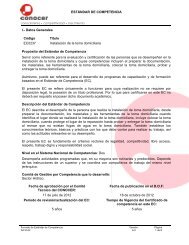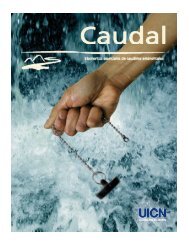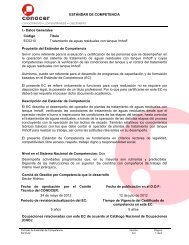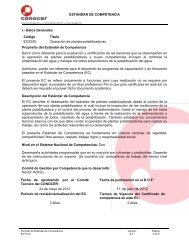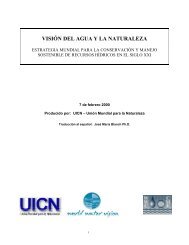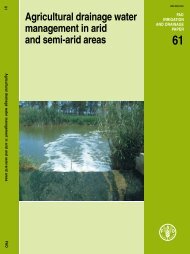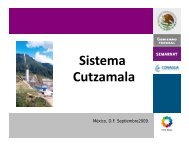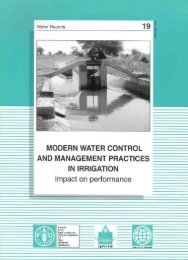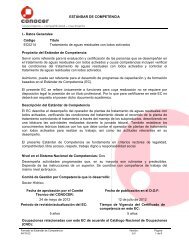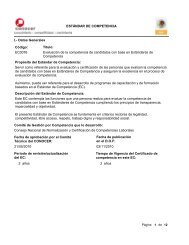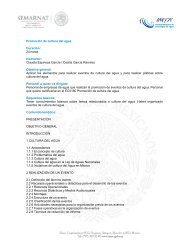Document - IUCN
Document - IUCN
Document - IUCN
You also want an ePaper? Increase the reach of your titles
YUMPU automatically turns print PDFs into web optimized ePapers that Google loves.
channels. The importance of the tanks is further supported, by the fact that the direct effect ofprecipitation on the groundwater table is found to be minor, except in the wet season when thesoil is saturated and water can be retained for a longer period.Thiruchelvam and Pathmarajah (1999) found that the groundwater table in the Kala Oya Basin,had generally risen in areas under the Mahaweli irrigation project. The higher groundwater tablewas recorded to affect shallow tube wells, in areas close to irrigation channels and to facilitatewater-logging, in low lying fields. At the same time, people living around the selected tanksreported that they had experienced, decreasing water levels in their wells since the irrigationproject started; especially in the dry season. Clearly the location of wells has a major influenceon the water level. Wells located adjacent to irrigation channels are more susceptive torecharge, than wells located in the command areas of the tanks. The decreasing water levelsbeing experienced in wells located in the command areas are linked to the availability of waterin the tanks. Since many tanks are loosing their storage capacity due to sedimentation, they areunder increasing threat of drying out during periods of the dry season. Furthermore, since theinitiation of the Mahaweli irrigation project, demand for tank water has increased. The irrigationchannels on the other hand, are provided with adequate water throughout the dry season.Unless the storage capacity is therefore improved, the wells dependent on the tanks forrecharge, risk losing their value.The 90% confidence interval found in Woodward and Wui, for ground and sub-surface waterrecharge was US$ 6-2,571 acre/year. Evidently, the distribution of values is very large betweenthe examined studies, which further underlines the importance of site-specific information.Below, the expected impacts on ground and sub-surface water recharge, under the fourscenarios are illustrated -ScenarioExpected impacts1 - - -2 - -3 +4 + + +Based on the assumption that the tank’s storage capacity will continue to decrease underscenario one, the impact on ground and sub-surface water recharge is perceived as verynegative.In scenario two the same will eventually happen even if increasing the spill extends the timehorizon, since sedimentation loads will remain high without proper management of thereservation area.Under scenarios three and four, the combination of increasing storage capacity along withmanaging the reservation will overall favour, water recharge. However, increasing the storagecapacity by removing silt will also benefit water penetration. In terms of ground and sub-surfacewater recharge, scenario four is therefore seen as the best option.Nutrient and sediment retentionMany wetlands, have the ability to act as natural water filtering stations, by storing nutrients,specifically nitrogen and phosphorus in their soil and vegetation, and trapping sediments. Forevery wetland, there is however a limit as to how high the nutrient concentration can be, withoutcausing adverse effects on, e.g. biodiversity. Accumulating nutrients stimulates eutrophication,especially in smaller water bodies, where the carrying capacity towards nutrients is fairly low.Although eutrophication is a natural process, it can be greatly accelerated by human activitiessuch as agriculture. Increasing the rate at which nutrients and organic substances enter aquaticecosystems, will add to the eutrophication process and stimulate algae growth. Increased algaeThe Value of Traditional Water Schemes:Small Tanks in the Kala Oya Basin, Sri Lanka45


